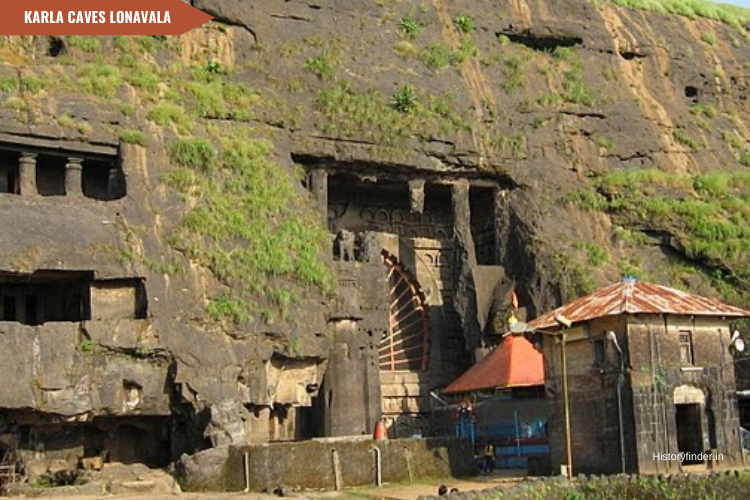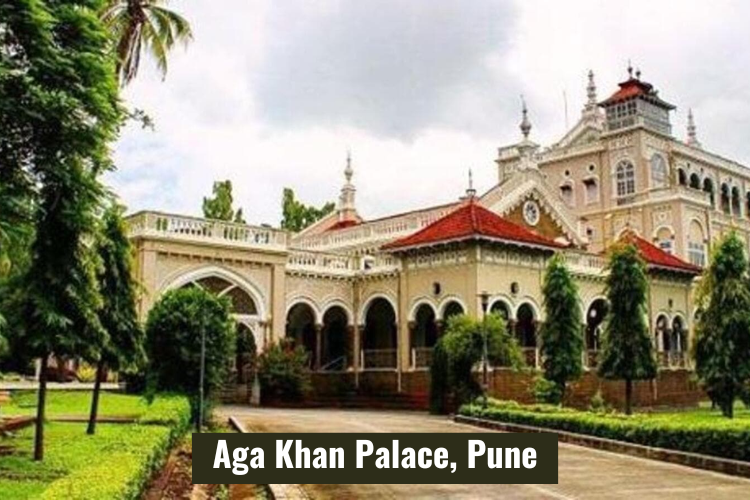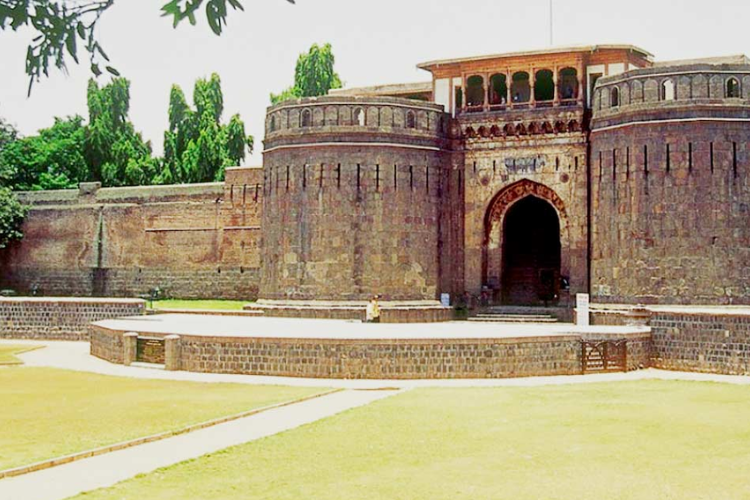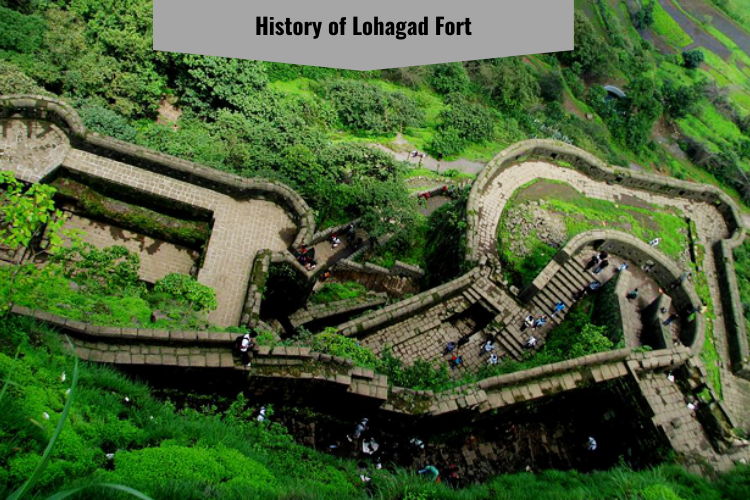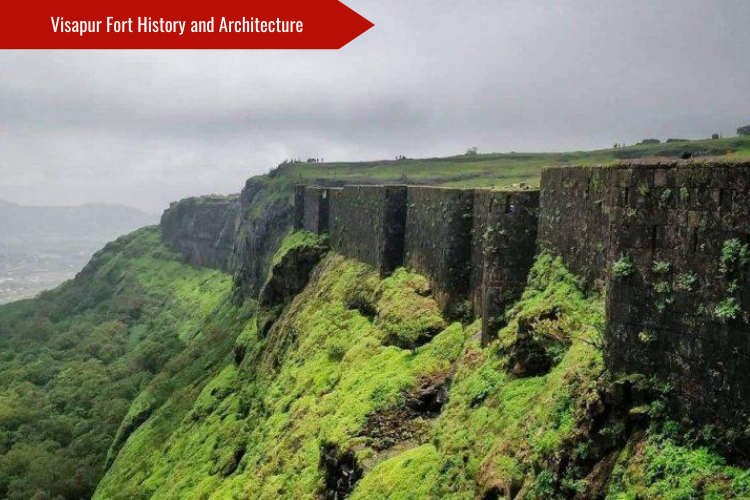Maharashtra is extremely rich in rock-cut Buddhist Caves datable from 3rd century BCE up to 7th century CE. Karla Caves near Lonavala is among the oldest rock-cut caves with rich history of Buddhist Architecture. The group of caves of Karla is definitely not the largest among the other rock cut caves nearby. But Karla Caves are still famous, especially for its Great Chaitya, largest Buddhist chiatya in Maharashtra and India.
The rock-cut caves of Karla, one of the oldest Buddhist monasteries, were functional until 5th century CE. Oldest cave shrine is datable to 2nd century BCE. But latest developments belong to 5th century CE. These caves are now protected monuments of Archaeological Survey of India (ASI).
Karla Caves appear at Maval Taluka of Pune district on the Pune-Mumbai highway, about 60 km northwest of Pune city. However, Lonavala is the nearby tourist destintion to Karla, just about 11 kilometers northeast. The location of Karla is also important for its rich embellishments. It is on the ancient trade route connecting lands of Deccan to the seaports of Kalyan, a prime location then to promote Buddhism.
Pune and Aurangabad districts of Maharashtra have plenty of old Buddhist caves. The rock-cut caves of Ajanta and Elora of Aurangabad are world famous for astonishing Buddhist arts. While the caves of Bhaja and Bedse are also quite famous Buddhist heritages near Pune and Lonavala region.
History of Karla Caves
Valuraka or Veluraka was the ancient name of Karla Caves. Karla being a natural cave, Buddhist Monks found this place easier for excavation. The Buddhist monastery of Karla also offered resting facilities to the passing traders. Karla or Karle Caves just rises about 45 meters height. Thus it was an easy access to the visitors as well.
Karla Caves belong to the Mahasanghika Buddhist sect, which gained huge popularity in this part of India. Hence the monastery of Karla had received several financial support from traders and Satavahana rulers. Several cave inscriptions display of mentions of such donations. Honestly, constructions like the great Chaitya is anyhow not possible without any royal sponsorship.

Karla Caves represent a group of 16 old Buddhist caves. Majority of the caves are datable to Hinayana phase typically from ‘Before Common Era‘ (BCE). Only 3 caves belong to the Mahayana phase datable to Common Era (CE).
Inscriptions of Karla Caves
Karla Caves are bearing about 22 inscriptions, all in Brahmi scripts, unfolds an imposing history of donations to the monastery. The inscriptions include the names and places of donors, mostly by royal families, merchants etc. Karla Cave inscriptions clearly speak about 27 individuals from various places.
Yavanas (Indo-Greek rulers) of Denukakata and Umehanakata had donated six of the Great Chaitya Griha pillars of Karla Caves. Those pillars still bear the names and locations of the Yavana donors. Dhenukakata is assumed to be Danahu, about 200 kilometers northwest to Karla Caves. Town of Umehanakata is however still unknown.

The Kshatrapa Nahapana inscription, appears on the lintel to the right of the Great Chaitya entrance. It elaborates the major charities made by the king to the monks living in the caves. The left lintel of Great Chaitya entrace bears an inscription of charity made by Satavahana king Sri Pulumavi (130-159 CE). Pulumavi inscription mentions about the donation of land to the Veluraka Samgha.
Both inscriptions at the Great Chaitya entrace gate mentioned about Valuraka, the ancient name of Karla Caves.
Role in expanding Buddhism
Buddhist monasteries of Karla and Bhaja provided resting facilities to the passing travellers. Monks would narrate the glory of Gautama Buddha’s life and achievements to the resting travellers. They would also provide all important insights into the life and belief system of Buddhism which impressed the travellers a lot.
Karla Caves served as one of the key Buddhist schools, spreading Buddhism in ancient times. The inscriptions and architectures of Karla suggest how the local rulers and merchants supported Buddhism.
Karla Caves Architecture
Karla Caves, the ancient Buddhist heritage of Maharashtra representing a classic rock-cut architecture. From the structural standpoint, Karla Caves are very similar to Bhaja Caves, another heritage nearby displaying ancient Buddhist Architectures. The Buddhist complex consists of two type of caves: chaityas (prayer halls) and viharas (dwelling places).
Chaitya architecture of Karla predominantly consists of arched entrances and vaulted interiors. Two rows of stone pillars bear the stone beams. Rib shaped wooden structures, standing on the stone beams, support the stone ceiling. Stone pillar often carry the names and other details of the donors. Cave 8 of Karla is the largest chiatya in India, hence often recognised as the Great Chaitya.
Viharas have completely different architecture and application in Buddhist monasteries. Karla Caves Viharas consist of small cells or chambers where the Buddhist monks lived. One of the Vihara cells also consists an inscription of Satavahana king Vasishthiputra Pulumavi.
Great Chaitya (Cave 8) of Karla
Karla Caves Great Chaitya (cave 8), measures about 45 meters (148 feet) in length and also rises to a height of 14 meters (46 feet). The largest rock-cut Buddhist prayer hall of ancient India is also notable for its splendid architecture.
The entrance of Great Chaitya cave is greeted by the iconic stone pillar on the left. It however looks like a plain shaft with sixteen flutes. But the pillar capital with four lions made it recognizable. It may had its pair on the right side. But probably removed to make space for the temple appears now. Some experts also say that the other pillar may had collapsed before the temple was constructed.
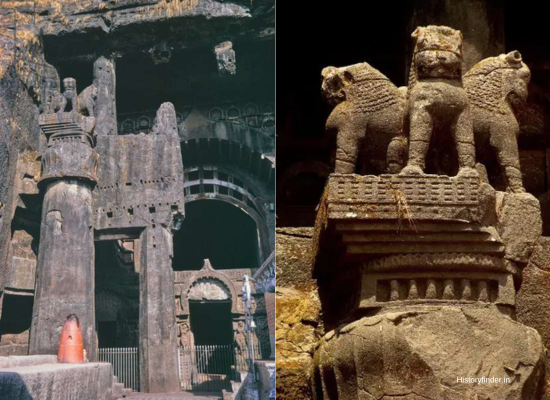
The entrance, consists of three dateways, one leading to the central hall, while others to the each of the side-aisles. Over the gallery, the whole end of the Great Chaitya hall is open, forming a single great window.
The sculptures at both sides of the entrance doors represent classic Buddhist arts. However, such physical forms of Buddha arrived during Mahayana phase, much later than the cave’s excavation.

Fifteen pillars on each side divides the cave into 3 sections: the central hall and narrow aisles on both side of it. Each pillar consists of a tall base, an octagonal shaft, and a richly ornamented capital. The capitals depict males and females riding lions, elephants, and other animals. A giant rock-cut stupa appears at the center but to the back end of the cave. Details of donors are inscribed at the pillars in Brahmi scripts.

Large horseshoe-shaped wooden rib beams supporting the ceiling, represent classic wooden architecture of 1st century BC. This ceiling architecture is almost identical to Chaitya Griha of Bhaja Caves. Horse-shoe windows allow Sunlights illuminate the interiors.
Architectural Development in Chronology
The Great Chaitya cave architecture of Karla has followed rather improved on other Chaitya caves nearby. Chronological analysis gives a clear picture how Chaitya Caves improved over the period. It probably started from Cave 9 of Kondivite Caves, followed by Cave 12 of Bhaja Caves and Cave 10 of Ajanta Caves around the 1st century BCE. Then it further continued with Cave 3 of Pitalkhora, Cave 1 of Kondana Caves, Cave 9 at Ajanta built about a century later. These caves showcased more ornate designs. Cave 18 of Nasik Caves to Cave 7 of Bedse Caves which finally arrived at the Great Chaitya at Karla Caves.
Therefore the Great Chaitya, the cave 8 of Karla, often referred as ‘final perfection’.
